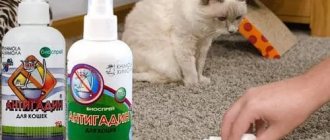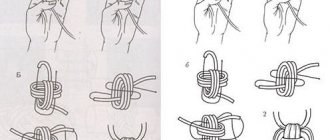Sterilization of cats is a abdominal operation to remove the reproductive organs of the animal. Most often, veterinarians make an incision along the linea alba. This area is easily accessible to the animal, so after the operation doctors strongly recommend putting a special blanket on the pet.
The blanket should be made of natural fabrics and be as comfortable as possible for the animal to wear for 7-10 days before removing the external seams.
It is advisable that the owner have several blankets, which will allow them to be changed and washed more often, keeping the wounds clean and protecting them from the penetration of pathogenic bacterial microflora.
In the absence of a blanket or a special bandage, the animal, after emerging from anesthesia, is able to lick the wound surface, even to the point of licking the suture material.
In addition, the animal can cause an infection or cause microtrauma with its rough tongue, which ultimately leads to inflammation of the suture.
Types of blankets and their purpose
Pet stores offer a large selection of blankets for cats. They differ from each other not only in size, but also in the material of manufacture, cut and purpose. So, protective clothing for cats is divided into:
- Warm blankets for protection from the cold. Mainly used for short-haired breeds of cats and sphinxes. Owners put sleeveless vests on their pets when taking them for a walk.
- Blankets for the home, in order to protect the owners from the shedding of the animal. This is especially true for people sensitive to various allergens. In addition, many owners do not want to constantly clean the apartment from a large amount of wool. Sphynxes also wear light cotton blankets to protect their furniture from stains. The fact is that hairless cats have an unpleasant feature - high sweating. Therefore, light clothing or a sleeveless T-shirt copes well with discharge and heavy shedding of fur. Some models of home blankets are also necessary for caring for seriously ill pets. In cats with tumors of the mammary glands, in order to avoid scratching the affected area, the owners put a blanket on their four-legged friend for constant wearing. For ease of wearing and removal, the ties on the blanket are replaced with a zipper.
- Rain blankets. This type of clothing is used when walking in cloudy and “dirty” weather. Made from nylon and vinyl chloride. Such protective equipment is used only on the street.
- Postoperative blankets. They became an excellent replacement for Elizabethan collars. Previously, cats were given collars after surgery. But this device is not entirely convenient. The pet cannot eat normally and move around the house with a collar, and as a result, recovery takes longer. Postoperative blankets have become the salvation of all domestic cats. After the operation, the animal feels good in protective clothing, recovers faster and can move freely around the apartment.
Why is a blanket put on an animal after castration or sterilization surgery?
When castrating or sterilizing, a central or lateral incision is made on the animal’s abdomen, onto which, after the necessary manipulations, 3–5 stitches are applied. To avoid complications and to speed up wound healing, the operated cat is put on a postoperative blanket - this is a large fabric bandage equipped with several pairs of ties or Velcro that are fixed on the back. A blanket for a cat after sterilization is necessary for the following purposes:
- Protection against infection. Through a wound, pathogens can penetrate the skin and cause inflammation.
- Preventing animals from licking external agents used to treat sutures.
- Protection from scratching. Since the incision site is itchy, the cat can scratch it until it bleeds, and damaged skin is an open gate for infections.
- Preserving the integrity of the seams. Without a blanket, the animal can damage the threads holding the edges of the wound together, which will lead to the sutures coming apart.
- Preventing mechanical damage.
- Prevention of abdominal sagging due to weakening or stretching of the muscle walls.
How to choose the right blanket for a cat?
If your cat is undergoing surgery, you should choose a blanket before surgery. Your pet will quickly get used to the protective bandage and will feel much calmer in the postoperative period. Buy two sets at once so that you can replace the blanket if it gets dirty.
Pet stores offer several types of blankets, they differ in material and size.
The material used to make protective clothing is non-woven fabric. It is dense, and if you trim it, it does not crumble, it perfectly absorbs various secretions and liquid, thereby leaving the damaged area dry. Doesn't stretch after several washes.
When choosing a protective postoperative bandage for a cat, give preference to natural fabrics; they provide air flow to the affected area.
To choose the right size, you need to weigh your pet and measure the circumference of the sternum. A correctly chosen bandage leaves a small part of the back open (up to 9 cm). The volume is regulated by ties. Standard models of blankets for cats up to 5 kg start with a size of 38 cm (body length) and a chest circumference of 30 cm. For pets over 5 kg, bandages measuring 42x35 cm are suitable.
The blankets also have some differences in the method of fixation. They mainly sell bandages with ties that are fixed on the animal’s back. Less popular are models with Velcro instead of ties. Such models are suitable in cases of temporary wearing of blankets, for example, after sterilization or castration. Thick blankets with a zipper are considered the most comfortable. They are easy to take off and put on, they do not come unfastened and do not hinder the pet’s movement. But compared to regular ties, zippered jockstraps are a little more expensive.
Options from improvised means
You can make a blanket from scrap materials, such as tights and socks.
A pantyhose bandage must be made from tights with good density. You can also use trouser legs and sleeves from already unnecessary clothes. Holes for the paws are made in such blanks. After use, such products do not need to be washed, but simply thrown away.
Sock blankets are suitable for kittens and teenage animals, since only they can fit into products of this size. Only a new, never used sock is suitable for production. Slots are made in it for the paws. The hole from the heel should be in the pet's groin. A cord can be used as a tie. This version of the bandage is not very reliable, since the animal can easily take it off.
Using tights, socks and other clothing to make blankets is a simple solution, but the material itself is not very suitable for performing the tasks assigned to the product. Therefore, it is better to sew a bandage from scratch from a more suitable material.
DIY blanket
If you want to sew a blanket for your pet yourself, you won’t have any difficulties. It’s easy to sew, and you can always find detailed diagrams and patterns on the Internet. It is best to select fabric for the bandage from your old things. The cat, feeling a familiar smell from the fabric, will feel much more confident and calm.
To make a postoperative bandage you will need:
- chintz or calico;
- ribbons;
- tools for work: pins, needles, threads, scissors, pencils and a ruler.
The dimensions of the pet are taken with a tailor's centimeter. Measurements needed to model the pattern:
- chest girth;
- length from withers to beginning of tail;
- peritoneal girth;
- the distance between the front and hind legs.
When cutting out parts, do not forget about an allowance of 0.5 cm. Before you start sewing, if you bought new fabric, be sure to wash it so that it shrinks.
Having cut out the parts, sew them together, machine the edges, and sew on fixing ropes. If desired, replace the rope with a zipper.
When preparing for surgery, prepare several blankets for each shift in advance to ensure your cat feels comfortable.
Observation after removal of the bandage
After the bandage is removed, it is necessary to carefully monitor the cat's condition in the first days. The cat family is characterized by increased cleanliness, therefore, at first the animal will constantly lick the seam.
The owner must ensure that the cat does not chew the edges of the healed wound.
Be sure to read:
Complications after castration of a cat: causes, types, symptoms and treatment, when you need to see a doctor
Important points during inspection:
- monitor the integrity of the edges of the wound surface;
- control whether there is any discharge from the wound in the form of blood or lymph;
- inspect the seam for redness, inflammation, and the appearance of purulent discharge;
- check whether nodes or swellings have appeared along the edges of the wound surface.
Any of the identified anomalies is a reason for an unscheduled visit to the veterinarian.
Features of care with a bandage
Sometimes it is necessary to treat the seam with special solutions and apply a bandage to it, but for this you do not always need to remove the blanket completely.
Sometimes all you need to do is untie a couple of tapes to gain access to the wound. If you remove the bandage completely each time, you will only cause unnecessary stress to your cat and slow down the healing process.
Important!
Make sure that the tightness of the ribbons is always in the same condition - not too loose and not too tight.
In the first case, the cat may scratch the wound or begin to lick it and lick off all the medications, which will negatively affect its body. In the second, you can provoke a lack of air or provoke friction of the seam against the fabric, which will lead to the wound festering.
Sometimes cats recover very quickly after sterilization and begin to lead an active lifestyle. Strictly ensure that the cat's activity during this period is limited - during excessive activity, the seams may come undone, or the blanket may get caught on the protruding corners of the furniture while jumping.
Reference!
When helping a cat relieve itself, you do not need to remove the blanket completely. All you have to do is untie the back.
How to wear a blanket correctly?
The effect of its action depends on how you put the blanket on your pet, so it is very important to do it correctly. It is recommended to do this together (as well as trimming claws, by the way) - one person puts on the blanket, the other calms the cat and does not allow it to escape. The sequence of actions should be as follows:
- Place the product on the table and carefully straighten all the ties.
- Next, you need to carefully lay the cat on the product and hold the pet a little. To make the animal a little distracted and less nervous, talk to it, stroke it, but hold it in such a way that there is no interference with tying the blanket and strong pressure on the cat, it is already in pain.
- Having laid the cat down, first fix the ribbons in the head and front paws. Tie the back ropes, then the ribbons in the waist area, if your bandage requires them.
When can I shoot?
When can you remove the blanket after sterilization? Here you should follow the recommendations of your veterinarian.
Important!
It is usually recommended to remove it after 10-15 days; the wound usually does not heal faster.
Dress for the sphinx
Using a simple pattern, you can make a beautiful dress for your hairless Sphynx cat. The most remarkable thing is that a dress of this kind can be made from just two pieces. First of all, the main part is made, and then the sundress, which is sewn to the base.
For your information! All this takes very little time, but looks very attractive. Do-it-yourself clothes for the sphinx, the patterns of which are presented in the picture below, can be made in a matter of hours.
Knitted suit on a Canadian cat
Using the fixture
The doctor puts a bandage on the cat immediately after sterilization, while the animal is under anesthesia. Before tying a protective blanket, press a sterile napkin soaked in an antiseptic to the wound. The blanket not only covers the damaged area of the skin, but also limits the animal’s movements. This is necessary so that the active scratch does not jump, otherwise the seams will come apart. The surgical incision is inspected and processed every other day, untying some of the tapes on the back and at the hind leg. If liquid appears on the surface of the fabric, the bandage is changed immediately.
After the surgeon removes the suture threads, the blanket is put back on the pet to protect the surface of the wound. But now the sanitary bandage is worn for 3–5 days. If the healing of the skin area is complete, the safety gown is finally removed.
How to fix it correctly
A blanket is laid out on the table and a cat is placed on top.
If your mustachioed beast is impatient, ask another person to gently hold her. Talk kindly and calm the animal
Ribbons of the first pair (at the neck) are tied together above the withers, and numbers 2 and 3 are crossed above the beginning of the back and secured in one knot. The ribbons at the hind legs are connected on opposite sides: the sixth on the right and the seventh on the left. Tied together. The remaining two pairs of ribbons (4 and 5) are tied on the cat’s back. Veterinarians recommend making the ends of 7, 6 and 5 rows of ribbons in one knot to reduce the inconvenience of wearing a blanket for the animal.
The blanket should not be tied too tightly to prevent swelling of the pet’s skin.
The bandage should not be tight or too loose. It is considered optimal if a finger fits freely under the bandage. When an animal cannot walk in a blanket and falls, the fastening above the ridge is too rigid and should be loosened. Make sure that the cat does not accidentally damage the ribbons.
How long can you wear it without taking it off?
If the wound is dry, there is no swelling or redness, then after 8–10 days the bandage is removed. But at the same time, the cat cannot be left alone. Watch how she behaves. If he begins to intensively lick the wound or injure the sore area, then he will have to put on the blanket again and show the animal to the doctor. The cause of restless behavior is probably hidden inflammation.
Video: a cat walks around the house with a large bandage tied on its back
Features of using the bandage
For a cat, an oval cutout is made on the belly under the tail using a purchased or homemade blanket. Otherwise, you will have to untie some of the ribbons from the back and turn back the edge so that the animal can go to the toilet. This is inconvenient for both the owner and the sick pet.
Our mustachioed friends have different views on being forced to wear a blanket. Some show hatred with their entire appearance and persistently try to remove it by biting the ribbons with their teeth. Others are cunning and pretend that the protective bandage does not bother them at all. The reason for this behavior is simple - the cat is patiently waiting for the ribbons on its neck to loosen. And one morning you find your pet without a bandage, which was left lying somewhere in the corner of the room. It turns out that the cat has already pulled out all the threads from the wound. It is good if the suture is almost healed, i.e. there is no bleeding or fluid discharge. In some cases, you have to take your unruly pet to the surgeon again. Then the treatment is delayed for months, and a scar remains at the site of the incision.











